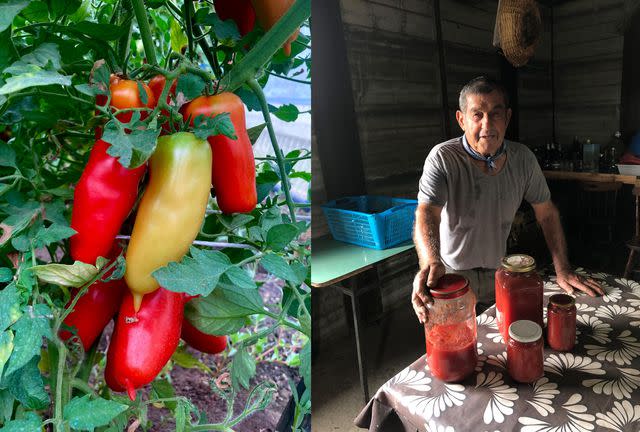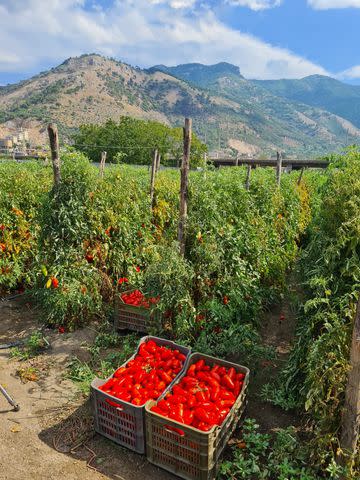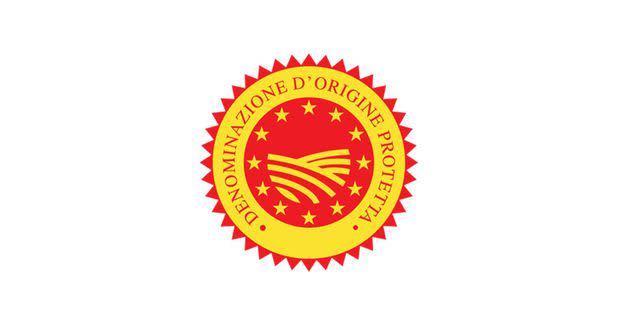That Can of San Marzano Tomatoes Might Be Fake—Here's How to Spot the Real Deal
San Marzano tomatoes are prized for their luscious flavor, but does that can of diced tomatoes or bottle of ketchup emblazoned with that name actually contain any? The answer may surprise you.

One morning this past June, Vincenzo Aufiero was tending to his San Marzano tomatoes. The day before, Vincenzo was also tending to his San Marzano tomatoes. And in the hotter and hotter days to come, yep—he was staking, fertilizing, weeding and eventually picking his San Marzano tomatoes.
Aufiero is 78 years old, and pretty much every summer day of his life has been spent in the lee of Mt. Vesuvius, working his land so that we all might put a better red sauce on our pasta. Sure, he and his wife grow grapes to make their own wine, along with potatoes, celery, radishes and arugula for their family's salads and pastas. He even fishes for eels and crayfish in the spring-fed sluiceway running along the border of his property.

But the focus of Aufiero's efforts on his 5,000-square-meter (1.2-acre) plot are the 8,000 San Marzano plants he puts in the ground every year, using a crude spike and his two gnarled hands. Which may be one reason you and other Americans feel a certain glow when you put a can labeled "San Marzano" in your shopping cart. Or why you can taste the particular tang of the volcanic soil and Campania sun in the luscious home-cooked pasta dish sauced with the iconic tomato.
Except, dear American consumer, that's not really happening.
"Let me ask you this," says Paolo Ruggiero. His family owns the canning and distribution company Gustarosso that buys Aufiero's tomatoes. "In all of the region that is certified to grow San Marzanos, we produce about 4 million cans of tomatoes per year. There are about 5.6 million people in the region of Campania alone. How can it be possible that so many cans in America labeled San Marzano are actually from [the region of] San Marzano?"
It's a good question, and one that confounds the 150 farmers that make up the cooperative supplying tomatoes to Gustarosso. Because when you add it all up, the total land under cultivation for certified San Marzanos is a scant 740 acres, each of them worked by nonnos and nonnas bent by years of hard but, to their minds, worthwhile labor. That the name San Marzano, a name that they work so hard to enshrine, is often spirited away and slapped on a can like the word "Kleenex" on a box of tissues, rankles, to say the least.
Related: Why the Most Expensive Spice in the World Is Now Growing in Hundreds of Small American Farms
"It makes me angry," Eduardo Ruggiero, the patriarch of the Gustarosso company, told me in a little office just off the company store, with its cans and cans stacked high and emblazoned with the signature Gustarosso red mustache label. "I know there are Italians and Italian Americans making millions on something that's fake. Meanwhile there are people in the field making way less money because we're not in the lobbying business."

Eduardo Ruggiero feels personally offended by the rip-off because around 1900 his grandfather, along with several other Campania farmers, made the first selection of seeds from plants that had been cultivated locally for centuries, breeding a variety that took particularly well to the sulfurous volcanic soil and harsh, salty air.
Related: Every Seed Has a Story—Meet the Company Working to Share Them
Then in 1992, the Italian government began to protect specific products with Denominazione di Origine Protetta, or in English, Protected Designation of Origin. D.O.P. regulations require that certain products like Parmigiano Reggiano cheese, balsamic vinegar of Modena, and, yes, San Marzano tomatoes, conform to a set of standards. In the case of the San Marzano, the tomatoes must be grown within the 41 municipalities around Mt. Vesuvius certified to bear the label. They must be planted far less densely than their industrial counterparts in, say, Puglia, and they must be planted, cultivated and harvested by hand.
Related: Why Our Future Depends on Healthy Soil
This, Vincenzo Aufiero showed me, has a certain homespun ingeniousness to it. He stakes every tomato plant to a gnarled old piece of chestnut wood which is marked off in three sections. Harvesting occurs three times in a San Marzano plant's life, starting from the bottom at the end of July, then the middle at the Ferragosto holiday (August 15) and once more at the end of September. The bottom-to-top approach means that each tomato is picked at its prime lusciousness.

Who is doing all the picking is another key to the nobleness of the San Marzano. Whereas many tomato plantations in the South of Italy may rely on illegal migrant labor to get their fruits off the vines, those in the San Marzano region call upon an army of near relations when harvest time comes. It is literally as Gustarosso advertises, "tomatoes, grown by grandmas and grandpas."
Related: This Company Has Raised Over $4 Million for Small Farms—Here's How
Since anyone can buy San Marzano tomato seeds and grow them, can them and turn them into just about anything, how do you make sure you're buying real-deal grown-in-volcanic-soil-and-picked-by-grandmas-and-grandpas San Marzano tomatoes?

First of all, as Eduardo Ruggiero points out, only skinned tomatoes either whole or in fillets can earn the San Marzano designation. "Today you see San Marzano puree, San Marzano chunked tomatoes, even San Marzano ketchup. But none of that can legally be certified as actual San Marzano." Second, consumers should avoid the label "San Marzano-style." It's not a style you're looking to eat but an actual, physical thing. Lastly, look for the D.O.P. designation that should be clearly displayed on the can.

Of course all of this adds up—real San Marzanos cost nearly three times as much as their industrially grown counterparts.
But if we were all to cough up a few dollars more when we choose our canned tomatoes, it might be possible for people like Vincenzo Aufiero to rest a little easier as they near retirement. "To tell you the truth, I'm getting tired," Aufiero told me as his children and grandchildren pulled up from Rome to share in a holiday feast. Was it all the picking he was doing I asked him? The staking? The moving around of irrigation and compost?
"No," he said. "The hardest part is preparing the ground, getting it ready so we can plant our 20,000 plants."
Preparing the ground.
Considering the backbreaking labor that goes into putting every single San Marzano in a can, I think we could all do a little more in preparing the ground of the supermarket, making sure that San Marzanos are recognized for all the love and labor that make them sweet.
Read the original article on Eating Well.

